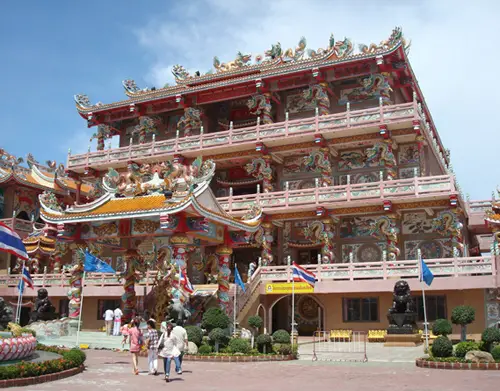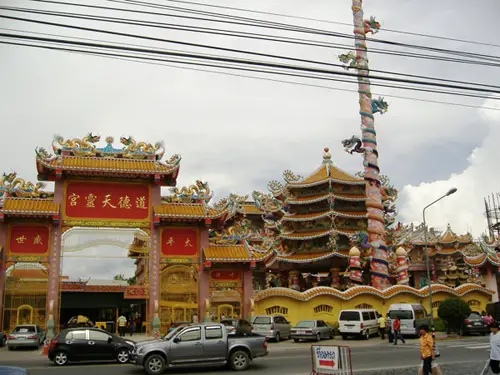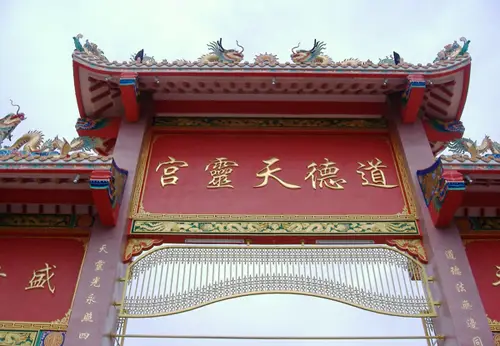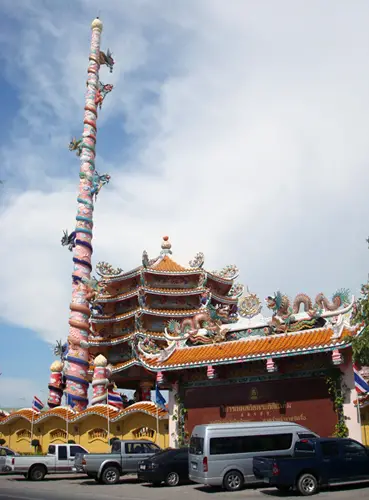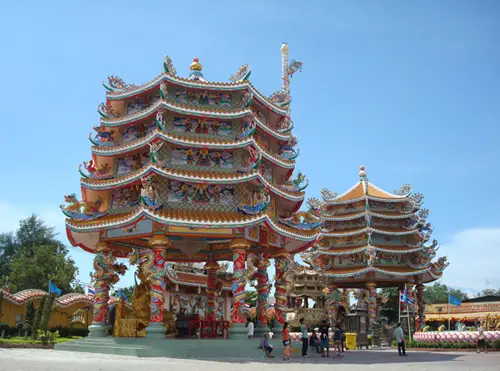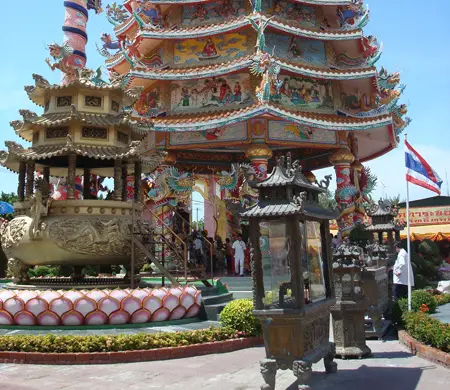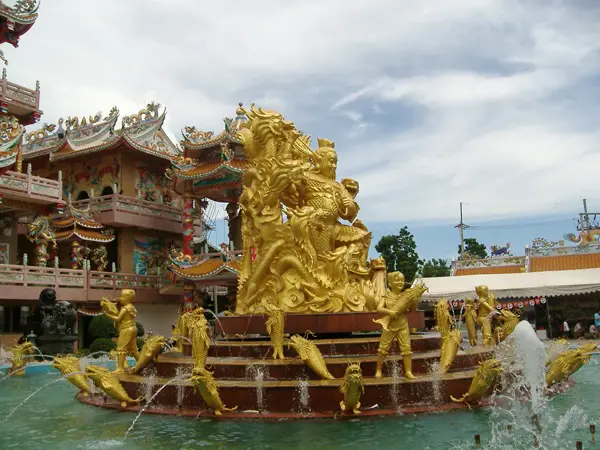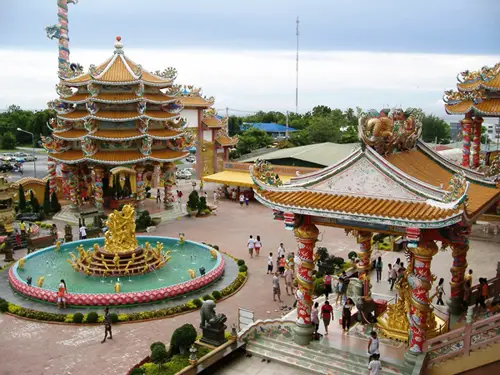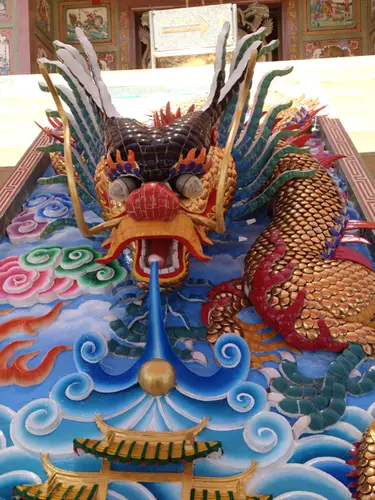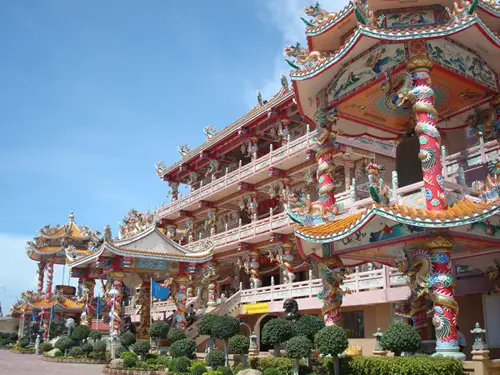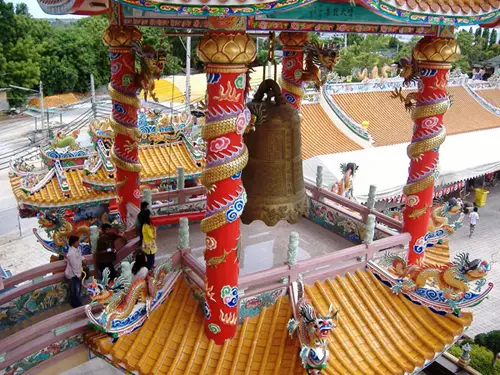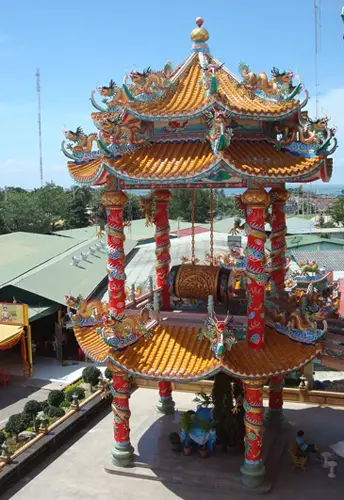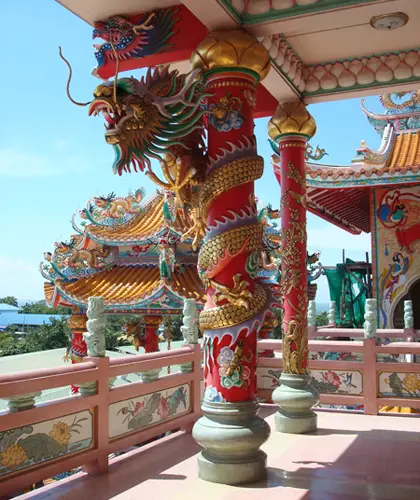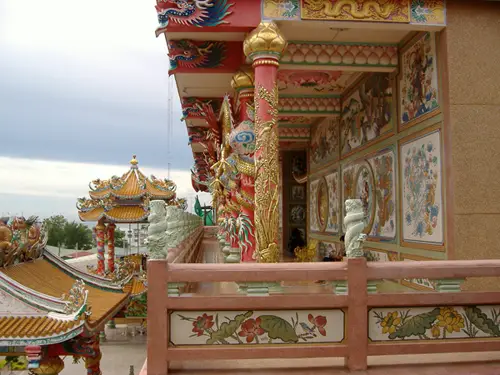Beginnings
Known as Nha Ja Sa Tai Jue Shrine to worshippers of Chinese origin, or Wihan Thep Sathit Phra Kiti Chaloem to the speakers of Thai, this imposing temple can easily match the architectural sophistication and meticulous details that are on offer at any of the more famous attractions to be found in the Chonburi area, a province not too far from Bangkok. Although it may not be as well-known in expatriate circles or with tourist agencies, the Chinese temple in Ang Sila, a small fishing village on the coast of the Gulf of Thailand has so far, up until now, unfortunately been living in the shadows of the far more “famous” venues that Chonburi province has to offer, such as its resort town of Pattaya, which favours foreign clientele, and the smaller town of Bang Saen with its Thai revellers.
But times are definitely changing and more and more tourists, mainly Chinese, now visit Nha Ja Sa Tai Jue Shrine to burn incense and offer prayers. The temple has become a strong religious centre in the local community and its affluence in both worshippers and donations is obvious to those who have frequented the temple in the last few years. Two decades ago, the place housed just a small Chinese shrine but when the Dharma Rasami Maneerat Foundation decided to celebrate the King of Thailand’s 72nd birthday in style, construction of a complex of buildings to accompany the shrine began in earnest.
Although the construction of the main hall was officially finished in 1999, only four years after work had started, anyone visiting the temple agrees that, with such a huge project, that kind of work never really finishes. This is true, especially when we have in mind that the Foundation owns a stretch of land surrounding the temple that adds up to 12,800 square meters and at 6,400 square meters, Wihan Thep Sathit Phra Kiti Chaloem occupies half of that, with plenty of space left to continue building.
And that is exactly what Dharma Rasami Maneerat Foundation is doing. Although the main building with its four stories is fully decorated and the adjacent buildings in the courtyard are complete, as you stand in the street in front of the temple you can easily see that construction is well under way on the right-hand side of the temple’s compound.
Having been built for such an auspicious occasion, the late Somdet Phra Nyanasamvara, the 19th Supreme Patriarch of Thailand, had presided over the opening ceremony. That event saw the casting of seven Buddha images and the Supreme Patriarch also presented the temple with relics of the Lord Buddha. To add to the honour, he also bestowed the name of the shrine, which means “Home of All the Gods.”
Main Gate and Wall
Like most Chinese temples, Nha Ja Sa Tai Jue Shrine is characterized by symmetry, with matching support buildings in the courtyard as well as two identical front gates which bear the name of the shrine carved in gold over a red background. On the other side of the gates, viewed from the temple courtyard, the walls of the gates are painted with meticulous scenes and calligraphy from Chinese mythology and folklore. The front gates are each comprised of five different entrances with a particularly large one in the centre and two smaller ones on either side. The gates are covered with a typical Chinese roof with gold tiles and colourful dragons protecting them, demarcating the threshold between the profane, our world, and the sacred, the world of the gods. As usual in such temples, only the middle, main gate of each entrance is open, but this is more than enough to accommodate the worshippers’ who come and go.
The two gates are connected by a wall painted in yellow and covered in a curve-shaped roof, with each segment of the wall having small grated windows. The front of the wall is bordered by beautifully maintained vegetation and stones, while huge bonsai (of the same kind that decorate the grounds of the Grand Palace in Bangkok) break the monotony and give the wall the most striking features. The Thai flag and other royal and/or religious flags accompany the angles at which each curve in the roof meet. As the temple was built right in front of the road that runs along the coast, a constant breeze keeps the flags fluttering in the wind, adding to the sense of wonder which the temple gives to any passersby.
The name of the temple, in Thai script and Chinese characters, is carved on a huge marble plaque halfway between the two entry gates. It goes without saying that such an important part of the temple has its own roof and its own protecting dragons decorating it. Thai royal symbols are displayed at the top of the roof, thus certifying the great importance that the temple has been given since its opening.
The Heaven-Earth Pole
Even before you walk through the front gates, you’ll notice a giant Heaven-Earth pole towering over the surrounding countryside. Located slightly to the left of the name plaque and inside the courtyards, this pole soars into the sky, symbolically connecting our world with that of the gods’. Painted in bright red, the pole has seven dragons of different colours slithering up to the top. The amount of detail on each and every dragon is amazing, with claws, whiskers and fangs clearly distinguishable even from a distance.
It is not surprising that the architects had chosen specifically seven dragons to decorate the Heaven-Earth pole, because the Chinese character for number seven sounds similar to the Chinese word for “arise,” thus neatly symbolizing the connection between earth and heaven, where worshippers hope their prayers will rise. The pole is supported by two smaller poles which barely rise above the height of the front wall but are, nevertheless, adorned with their own, smaller dragons.
The Courtyard’s Two Identical Shrines
As you walk through the temple compound you’re once again bombarded with the bright red and gold decorations that cover all the buildings of the courtyard. By the side of each gate, there are two identical shrines, supported by eight pillars on an octagonal base covered in marble with a pagoda-like five-tier roof. Again, Chinese numerology comes into place and, as most people come to these shrines to pray for wealth, it is thus not surprising that the Chinese word for the number eight sounds similar to the word for “prosper” or even “fortune” in some Chinese regional dialects. The ceiling of each shrine is decorated in sky-blue colours with different Chinese religious symbols, while huge chandeliers illuminate the statues at night.
The two shrines house two different Lord Buddha statues and are raised on a rostrum well above the head of a kneeling worshipper. A devotee would take off their shoes before stepping on the polished marble floor of the shrine and kneel in front of the statue. An offering table where believers can place flowers and food offerings has two plush upholstered cushions at its base. At the end of their prayers, the devotees touch these cushions three times in a row, with their palms raised to their forehead in prayer and then walk to the front of the statue to place three or nine scented bunch of joss sticks in a high receptacle filled with sand. With another quick movement of the joined palms to the forehead, the worshipper then moves on to the next shrine at the opposite gate, repeating the whole ritual once again.
The Censer
Between the two shrines, facing the back of the wall with the name plaque of the temple, there’s a censer made of bronze with a three-tiered roof and a small ladder leading up to the edge of its round bowl. Here, devotees reach inside to place their sticks of incense in the sand-filled receptacle. Facing the censer are four smaller bronze receptacles where one can place candles and light up their incense sticks.
Most worshippers buy the incense sticks and candles from the temple itself, while only a few bring their own from home. As going to the temple regularly also means making a donation of money, people would, no doubt, prefer to buy whatever they need to perform their rituals at the temple.
Donations and the Souvenir Shop
As you stand outside in the street facing the temple, walking in from the left front gate and immediately turning left will bring you to a roofed area where you can purchase incense sticks and candles as well as make your money donation to the temple. Depending on the phase the construction of the adjacent buildings is in, you can also purchase tiles for its roofs and have your name written on them. During formal religious ceremonies, the temple benefactors provide whole kitchens for worshippers to eat at, totally free of charge. Also, it is there where, dressed all in white, scores of believers gather regularly for Dharma meditation sessions.
On the opposite side, by the right gate, an air-conditioned building, sporting all the decorations of a wealthy Chinese temple, sells amulets, Lord Buddha statues, and other religious paraphernalia. The room is packed to the ceiling with fragile statuettes so one should be sure not to make any brusque movements as everything there is quite pricy but, supposedly, original and of high quality. Clean, free public toilets can be found behind this “souvenir” shop.
The Lotus Pond
It is difficult to decide which of the buildings and architectural features that make up the courtyard are its centerpiece. The sumptuous architectural designs make any of the buildings facing the main hall equally impressive and important. But, if there’s something that stands out completely from the visual invasion of details that worshippers are bombarded with, then it must be the lotus pond with its numerous water sprinklers, statues of golden fish, and figurines surrounding the main entanglement of dragons in the middle of the pond. The water is always clear but, unlike most Thai temples, there are no fish or turtles swimming in it.
The Courtyard
The courtyard is open to the rays of the sun which shine mercilessly for most of the year in Thailand and thus, apart from standing still for a photo shot, most people going to Wihan Thep Sathit Phra Kiti Chaloem hurry inside the main temple building. Also, it is not uncommon to see the Thais walking around the courtyard holding umbrellas over their heads to protect themselves from getting a suntan. The situation is quite different in the evening, when the floodlights brighten up the place, making the courtyard especially welcoming.
The Steps to the Main Hall
The steps leading up to the first floor of the main hall are flanked by two small gardens of flowers and small trees over which, the statue of a singh, the mythical guardian lion, watches over on each side of the steps. Poles displaying the Thai national flag, alongside royal and religious flags, are firmly implanted in the soil of the garden. A cacophony of shoes and flip-flops rest at the base of the steps, where a sign informs worshippers of the temple’s no smoking policy as well as the prohibition of taking photographs inside the hall and that bringing food and beverages inside is also forbidden.
After having removed your footwear, you step on green marble steps and, if you don’t have socks on, are immediately aware of the heat emanating from the steps. A few quick strides up the steps bring you under the roof covering the steps, a structure with its own dragon-decorated columns, chandelier and vivid murals. But, by now, you will probably be immune to these decorations and what catches your eye is the golden statue of a mythical Chinese god, wielding a spear while standing on the coiled body of a dragon.
No opportunity is wasted, so another red box encourages worshippers to offer yet another donation on their way up to the main hall. You do that, still amazed at the level of details surrounding you. Up you go and, in the centre of the steps, behind the golden statue, the base-relief of a dragon seems to emerge out of blue painted skies, while golden fish “jump out of the water.” At the base of this painting/sculpture, golden temple gates have their own 3D roofs. A “no touch sign” warns you to keep your hands to yourself, although the impulse to reach out and touch the whiskers of the dragon is immense and intense!
The Main Hall
As soon as you’ve taken in the surroundings of the courtyard and the area at the entrance of the stairs, you are all of a sudden assaulted with the magnitude of the main building which was painstakingly decorated with similar intricate carvings, base-reliefs, dragons, and figures of demons. Each level of its four floors is, in specific Chinese style, decorated with a clutter of ornaments and various sacred items. The murals on each and every wall depict scenes from traditional Chinese folklore, while a score of gods, historical figures, statues of the Lord Buddha and other Chinese deities fill every corner on each level.
The main hall is basically located on the second floor, accessible via the front steps, while the first floor, under the stairs is used for administrative and storage purposes. The main hall, also sometimes referred as the first hall, contains a shrine housing the main image of the temple. The two other halls on the third and fourth floor complete the three main shrines which are required in every Chinese Buddhist temple.
A multitude of statues of Chinese gods, Buddhas and historical figures flank each side of the three walls while the main image sits on raised pedestals at the centre of the far wall facing the entrance. The area in front of the main image is filled with tables for offerings, stands for other religious figures and even more donation boxes. The offering tables are usually full of food, flowers and various other offerings, including toys and small figurines. When the deity has “finished” with these offerings (that is, when the tables are full), the temple staff remove them, eating the food or donating it to charities.
Worshippers kneel on an area covered with a large carpet and, after bowing and praying, they usually take a cup full of chim, which is a collection of numbered bamboo sticks used for divination, or seeking knowledge of the future, and still in a kneeling position with their head bowed, the inquirer shakes the cup until one stick falls out onto the carpet. If more than one stick emerges out of the cup simultaneously, they’re all put back and the ritual of shaking the cup starts once again. The number on the stick is then used to locate a small piece of paper from a rack full of little holes, each holding copies of descriptions for every number on the chim. The information on these sheets of paper details, in a very vague manner, your future fortunes.
Statues of God, Deities and Heroes
After you’ve finished your prayers and divinations, it’s time to walk around the main hall and explore its statues, decorations and murals. Huge chandeliers cast bright light on the various deities exhibited and, if you’re knowledgeable enough, you can make some sense of the clutter of gods, goddesses, Bodhisattvas (enlightened beings) and Buddhas displayed alongside mythical animals and human beings (such as heroes or historical figures). Two of the main images situated there are that of the NachaSa Tai Chue god and the 1000-handed Bodhisatava Kwan Yin image, referred to by Thais as Mae Kwan Yin, or Mother Kwan Yin.
Among these statues, worshippers are most likely to find the deity that they are “looking for” and make an extra prayer and donation, hoping for health, love, success, wealth or whatever requests they might have. Some of the statues were previously donated by well-to-do benefactors of the temple and, apart from statues bought or ordered from China, it is not unheard of for rich Thai families to donate important family heirlooms to the temple.
The Bell and Drum Towers
From the main hall, the worshipper then has the option to go up to the next floor, using the stairs on the right hand side, or step out on to the balcony to the bell and drum towers. Situated on each side of the stairs below, in the corners of the main building, these two towers are an integral part of any Chinese temple. It’s rather needless to note, but the towers are fully decorated with two levels and three roofs, one for the ground level and a two tiered one for the upper level. The ground level is used as a place of rest, each having a round marble table surrounded by marble stools for people to sit on under the shade of the roof.
The bell, located in the right-hand side tower, is made of bronze, has massive proportions and is decorated with the customary dragon and Chinese characters. Most worshippers who stop by the bell tower actually stop there to toll it by using an equally large wooden “stick” hanging from the ceiling being held by two long chains. The metal end of the stick connects with the bell in a designated area, creating an eerie sound which then gradually fades away.
In ancient times, the bell was used to tell the time and call the faithful to worship, but as we now all have several devices to tell the time and the temple doesn’t lack any worshippers, it is mainly used by believers in relation to their prayers. Thus, the sounds of the bell accompany the worshipper’s prayers to heaven. Apparently, the silence following the tolling of the bell stands for the “eternity” of the gods.
From the bell tower you can then walk along the first floor balcony to the opposite drum tower where one repeats the ritual by hitting the drums using smaller sticks which can be easily held in one hand. Grabbing the stick with two hands and doing a baseball-like swinging motion before hitting the drum will definitely make a greater noise. The short bursts of tick-tick which the worshipper creates by hitting the drums, represents the passing of “time” and contrasts with the bell’s sound fading into “eternity.”
The Third and Fourth Floors
Being out on the balcony also gives you the chance to take out your camera and snap away some wonderful pictures. An abundance of decorations, dragons, and murals gives people plenty of things to photograph. From the balcony you return to the inside of the hall and take the stairs up to the second and then third halls of the upper floors. Although slightly smaller, you will encounter much of the same collection of statues and decorations there.
If you can read Chinese or Thai, you will be able to learn the names of the statues you stop at while, if you approach one of the floor volunteers, you might also obtain a few explanations about the meaning and history behind each exhibit.
A Balcony with a View
Once you reach the balcony on the fourth floor, you are welcomed not only by a cool breeze sweeping over from the sea and clearing your mind of the religiously dense atmosphere from inside, but you’re also blessed with a grand view of the temple’s courtyard. The buildings that traditionally make up the layout of a Chinese temple are there for you to absorb in every detail and, regardless of your interest in visiting the temple, which could be religious, architectural or purely as a tourist attraction, you will definitely be awestruck by the immense effort that NhaJa Sa Tai Jue Shrine has required from its artisans who built it.
A few stylized benches give you the chance to have a rest under the brightly decorated ceiling and, if you have not yet burnt any incense by now, you could do it right there, in front of the stunning view of the sea. At the centre of the balcony sits a massive bronze censer flanked by two oil lamps, where you can light up your incense sticks from a small lit wick placed in a cork floater. The lamps are always well supplied with oil, as oil is a popular offering, with several symbolic meanings, from giving light to making things work smoothly. The smoke will rise high up in the air, floating to the heavens where the gods will listen and, maybe or hopefully, actually grant your wishes.
Adjacent Buildings
The Chinese Temple at Ang Sila is constantly expanding and you’d be amazed at how many additions are made from one trip there to another. You can now cross from the main hall to the adjoining building on the right via bridges which branch out from the sides of each balcony. These new buildings are also worth a visit, but you would most likely be welcomed by similar Chinese decorations and symbols.
The Temple’s Location
Wihan Thep Sathit Phra Kiti Chaloem is located on the road between the Old Market at AngSila and Khao Sam Muk monkey hill in Bang Saen, about 5km from downtown Chonburi City. The temple is open daily from 8am to 5pm on weekdays, while on Saturdays it stays open until 6pm and on Sundays until 8pm. The entry is free and, if you drive, a score of volunteers will help you park your car without expecting a tip. For more details regarding the time and dates of special religious services and festivals, you can call 03 839 8381 for some helpful advice.
For those who are interested in more details about Chinese (and Japanese) temples throughout Asia, I recommend James Baquet’s excellent website which provided both the inspiration and the basic temple terminology that was used in this article.
A much shorter version of this article was initially published in Mango Metro (January 2014, Vol.8, No.2)
